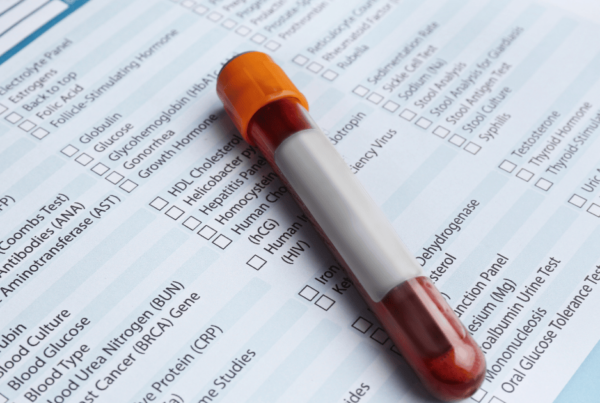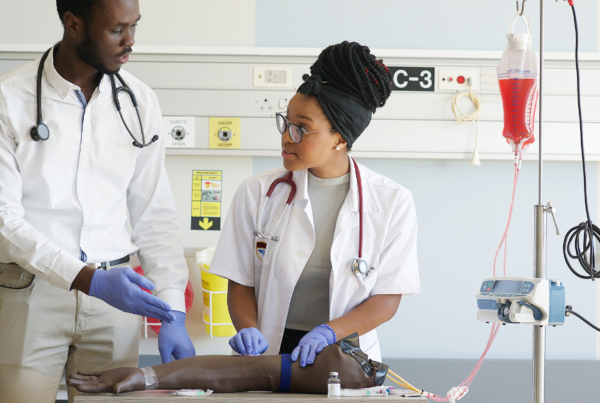In the world of phlebotomy, successful blood draws hinge on your ability to locate and access suitable veins. Mastering venipuncture techniques across various anatomical sites is crucial for aspiring phlebotomists. This guide delves into the 8 sites of venipuncture, equipping you with the knowledge to confidently perform safe and efficient blood collections.
| Key Takeaways: 8 Sites of Venipuncture |
| Understand Anatomy: Comprehensive knowledge of vein anatomy and physiology is crucial. |
| Patient Assessment: Evaluate each patient individually to select the most appropriate venipuncture site. |
| Skill Development: Practice venipuncture techniques regularly to build confidence and proficiency. |
| Patient Comfort: When picking a vein, consider age, anxiety level, and arm dominance. |
| Hygiene and Safety: Follow strict aseptic techniques to prevent infections and complications. |
What is Venipuncture?
Venipuncture is the process of puncturing a vein to draw blood, typically using a needle. This procedure is fundamental in medical diagnostics and treatment monitoring. Certified phlebotomists perform venipuncture to collect blood samples for laboratory testing, transfusions, donations, or research.
The Importance of Choosing the Right Venipuncture Site
Selecting the correct venipuncture site ensures patient comfort, reduces complications, and improves the quality of the blood sample. Each site has specific advantages and potential challenges, making it vital for phlebotomists to understand their options.
The 8 Essential Venipuncture Sites:
- Median Cubital Vein (MCV):
- Location: The antecubital fossa, the crease of the elbow.
- Advantages: The gold standard for venipuncture. Large, easily accessible, stable, and less discomfort for the patient. Ideal for beginners due to its straightforward access.
- Considerations: May be less visible in obese patients or those with poorly defined musculature.
- Cephalic Vein:
- Location: Outer aspect of the forearm, running from the wrist to the shoulder.
- Advantages: A good alternative to the MCV when it’s inaccessible. Relatively easy to access and causes minimal discomfort.
- Considerations: Less stable than the MCV and may roll during puncture.
- Basilic Vein:
- Location: Inner bicep area, deeper than the MCV.
- Advantages: Alternative when other sites are unavailable.
- Considerations: Deeper location makes access slightly more challenging. Potential for rolling, increasing difficulty and discomfort for the patient. Not recommended for beginners.
- Median Antebrachial Vein:
- Location: Between the MCV and basilic vein on the anterior forearm.
- Advantages: Viable option for pediatric patients or adults with small MCVs.
- Considerations: Smaller size compared to other primary sites. Requires skilled technique for successful puncture.
- Dorsal Hand Veins:
- Location: Top of the hand, visible through the skin.
- Advantages: Alternative for patients with inaccessible arm veins.
- Considerations: Fragile and prone to movement, demanding a high level of phlebotomy skill. May cause discomfort due to smaller size.
- External Jugular Vein (EJV):
- Location: Side of the neck, visible through the skin.
- Advantages: Considered a last resort due to the presence of alternative sites and proximity to vital structures.
- Considerations: Use with extreme caution. Requires advanced phlebotomy skills and should only be performed by qualified healthcare professionals in controlled clinical settings.
- Scalp Veins:
- Location: Located on the scalp.
- Advantages: Primarily used for infants and young children when peripheral veins are inaccessible.
- Considerations: Requires specialized training and should only be performed by qualified healthcare professionals in appropriate settings.
- Femoral Vein:
- Location: Groin area.
- Advantages: Absolute last resort due to deep location and potential for nerve damage.
- Considerations: Should never be attempted by aspiring phlebotomists. Requires advanced training and expertise reserved for qualified healthcare professionals in critical situations.
Choosing the Right Venipuncture Site: Beyond Location
Selecting the optimal venipuncture site goes beyond just anatomical location. Here are crucial factors Phlebotomy Now School emphasizes when training its students:
- Order of Veins for Venipuncture: The median cubital vein is typically the first choice due to its size, stability, and ease of access. The cephalic and basilic veins are considered next.
- Veins in Arm for Venipuncture: Common sites include the median cubital, cephalic, and basilic veins. Understanding the anatomical layout and individual patient’s vein condition is crucial.
- Foot Venipuncture: Although less common, foot venipuncture can be an option when arm veins are not accessible. This requires specialized knowledge and skill.
- Phlebotomy Equipment: Proper equipment selection, including needle gauge and length, tourniquets, and collection tubes, is vital for a successful blood draw.
- Blood Draw Order: Adhering to the correct order of draw prevents cross-contamination and ensures accurate test results. This order typically follows specific guidelines to prioritize certain types of tests.
Beyond the Basics: Mastering Venipuncture Techniques
Phlebotomy Now School’s curriculum equips students with not only theoretical knowledge of venipuncture tourniquet application, needle selection, and proper blood collection techniques, but also the practical skills to confidently perform venipuncture across various anatomical sites.
Here are some key considerations for mastering venipuncture techniques:
- Aseptic Technique: Maintaining a sterile environment throughout the procedure is paramount to prevent infection. This includes proper hand hygiene, use of sterile supplies, and adherence to established protocols.
- Needle Selection: Choosing the appropriate needle gauge and length depends on the selected vein size and depth. Phlebotomy programs provide guidance on needle selection for different venipuncture sites.
- Tourniquet Application: Applying a tourniquet correctly helps to distend veins, facilitating easier needle insertion. However, improper application or excessive tourniquet time can compromise blood flow and patient comfort.
- Needle Stabilization: Once the needle is inserted, proper stabilization techniques ensure smooth blood collection and minimize the risk of vein puncture.
- Blood Collection: Maintaining a gentle vacuum during blood draw prevents hemolysis (destruction of red blood cells) and ensures sample integrity for accurate testing.
Venipuncture Complications and How to Avoid Them
While venipuncture is a generally safe procedure, certain complications can arise. Phlebotomy Now School emphasizes proper technique and risk mitigation strategies to minimize the occurrence of these complications.
- Hematoma: Bruising caused by blood leakage from the puncture site. Applying gentle pressure after needle removal and proper tourniquet application can help reduce the risk of hematoma formation.
- Fainting (Vasovagal Syncope): This can occur in some patients due to the sight of blood or the needle insertion process. Creating a calm and reassuring environment, having the patient lie down during blood draw, and avoiding prolonged tourniquet application can help prevent vasovagal reactions.
- Multiple Puncture Attempts: Unsuccessful needle insertion attempts can cause discomfort and extravasation (leakage of blood into surrounding tissues). Careful vein selection, proper needle angulation, and skilled technique are crucial to minimize the need for multiple punctures.
- Nerve Damage: Inadvertent puncture of a nerve during venipuncture can cause pain, numbness, or tingling. Knowledge of vein anatomy and proper needle placement techniques are essential to avoid nerve injury.
The Importance of Proper Training and Phlebotomy Technician Certification
Venipuncture is a critical skill in healthcare, and proper training is essential to ensure patient safety, minimize complications, and achieve successful blood draws. Phlebotomy Now School’s accredited phlebotomy technician training programs provide students with the comprehensive knowledge, practical skills, and clinical experience needed to excel in this rewarding field.
The curriculum covers not only venipuncture techniques but also:
- Anatomy and physiology of the circulatory system
- Phlebotomy equipment and proper handling procedures
- Blood collection procedures for various tests
- Quality control and specimen handling
- Effective patient involvement requires good communication and interpersonal skills.
- Ethical considerations and legal aspects of phlebotomy practice
By successfully completing a phlebotomy technician training program and obtaining relevant certifications, graduates are well-equipped to launch a successful career in various healthcare settings, including hospitals, clinics, and laboratories.
Conclusion
Mastering the 8 sites of venipuncture is a core skill for aspiring phlebotomists. By understanding the advantages and considerations of each site, along with the importance of proper technique and patient comfort, you’ll be well on your way to becoming a skilled and confident phlebotomy professional.
FAQs about the 8 Sites of Venipuncture and Techniques
What is the most common venipuncture site?
The median cubital vein is the preferred site due to its large size, easy access, and stability.
When would a phlebotomist use a vein in the neck or scalp?
The external jugular vein and scalp veins are only used in extreme cases or with pediatric patients when peripheral veins are inaccessible. These sites require advanced training and expertise due to their proximity to vital structures.
What can I do to minimize discomfort during venipuncture?
Communicate any anxieties you have to the phlebotomist. Taking slow, deep breaths and looking away during needle insertion can also help ease discomfort.
What happens if a phlebotomist misses the vein during needle insertion?
Multiple puncture attempts should be avoided whenever possible. A skilled phlebotomist will select a different, more suitable vein to minimize discomfort and extravasation (blood leakage).
How can I become a certified phlebotomist?
Enroll in an accredited phlebotomy technician training program like those offered by Phlebotomy Now School. These programs provide the comprehensive education and clinical experience needed for certification and a rewarding career in phlebotomy.
By understanding these key takeaways and frequently asked questions, you’ll gain a solid foundation on venipuncture sites, techniques, and the importance of proper phlebotomy training.


